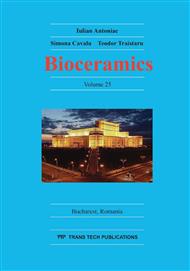p.229
p.233
p.239
p.245
p.249
p.255
p.263
p.269
p.275
Development of a Novel Hybrid Porous Scaffold for Bone Tissue Engineering: Forsterite Nanopowder Reinforced Chitosan
Abstract:
In order to induce bone regeneration several natural and synthetic materials have been proposed. However, single-phase scaffolds present some insurmountable disadvantages such as poor mechanical strength or brittleness and too low or too high degradation rate. In order to overcome these drawbacks, composite systems can be an interesting and promising option. In the present work a novel hybrid porous scaffold for bone tissue engineering is proposed. Chitosan/Forsterite (Ch/FS) composite scaffolds were prepared by freeze-drying method using a chitosan/forsterite ratio of 90/10. The FS nanopowder (Mg2SiO4) is synthesized using a simple solgel based method. The FS composition was checked by XRD analysis. The macrostructure of the Ch/FS scaffolds were analyzed by SEM, the FS distribution within the chitosan matrix observed by EDS, the mechanical strength measured by compression test in PBS and the biocompatibility of the composite on human osteosarcoma cell line (MG-63) verified by MTT assay after 48 hours. The porosity appears interconnected and with a pore size ranging from 1 to 100 μm. The FS is overall distributed within the chitosan matrix. The compression strength of composite scaffolds increased with respect to the pure chitosan scaffolds of more than two times (from 0.8 to 1.9 KPa) and the composites did not show any toxicity effect on human osteosarcoma cells.
Info:
Periodical:
Pages:
249-254
Citation:
Online since:
November 2013
Keywords:
Price:
Сopyright:
© 2014 Trans Tech Publications Ltd. All Rights Reserved
Share:
Citation:


